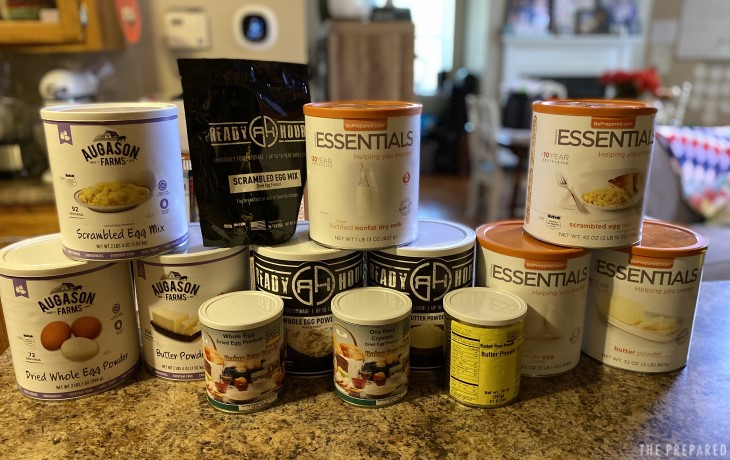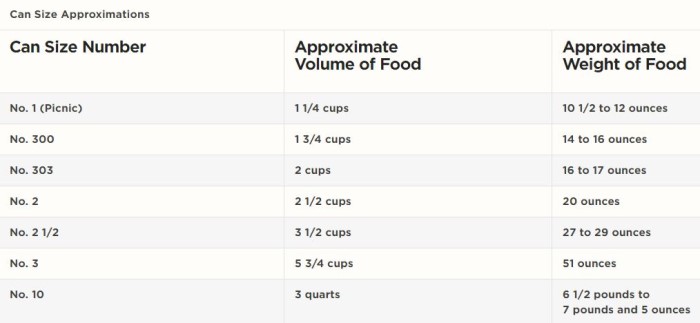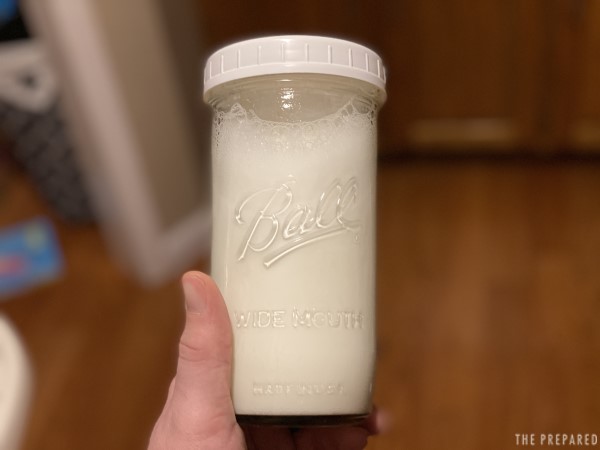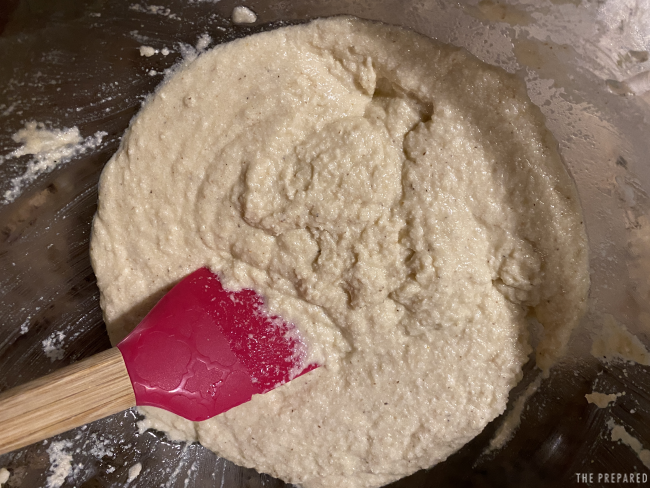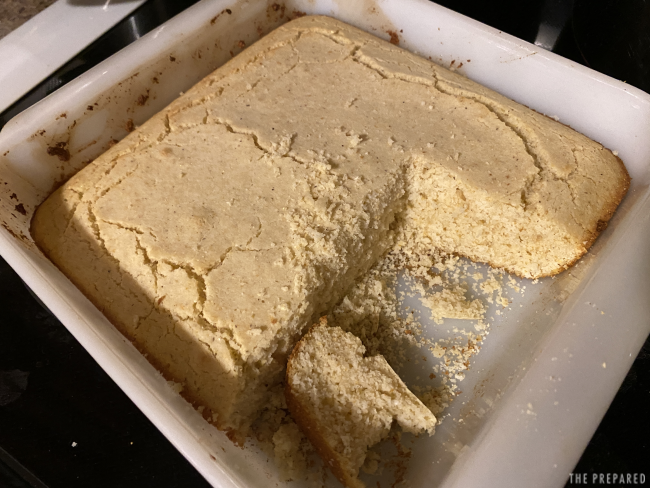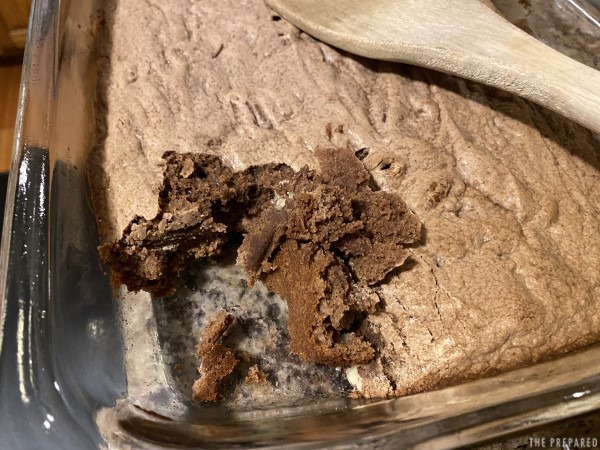Preparedness-focused suppliers sell a wide variety of canned foods that you usually wouldn’t otherwise find in cans, like bananas, broccoli, celery, and eggs. Unlike regular canned foods, these foods are dried through a special process and packaged with an oxygen absorber to prevent spoilage. And unlike supermarket canned wet foods, which only last a few years, these dried foods can sit on the shelf unopened for decades. Once opened, they can last for months.
Some foods are sold freeze-dried, which preserves their flavor, texture, and nutritional value. As a result of the freeze-drying process, they also weigh less. Meats, vegetables, and even whole meals are preserved this way.
More food guides:
- What to buy from the supermarket for short-term pantries, a great place to start prepping with “normal” food
- Best “prepper food” meal kits, similar to these staple ingredients, but premixed into meal variety packs
- Best lifeboat ration bars, great for go-bags!
- Best MREs and why you should skip them
The cans these foods come in are also different than what you might be used to. They come in large #10 cans (think of a coffee can), which are durable vessels well suited to long-term food storage.
These foods are rather expensive and tend to not taste as good as their fresh or wet-canned counterparts, so they shouldn’t be the front lines of your food storage, but they can add some much-welcome variety to your food preps, and let you make dishes you otherwise couldn’t in tough times.
The most important bits:
- Dehydrated foods are most often sold in large #10 cans, which refers to an industry classification of the can’s size (vs. #3, for example)
- This type of food is great for products that are otherwise hard to store for the long term, such as butter, eggs, and milk
- Also consider foods that don’t otherwise work well with canning, such as grapes, cauliflower, and celery
- Dehydrated food can last for decades unopened, and for up to a year after opening
- Many foods are sold in #10 cans, but it doesn’t make sense to buy things like salt and sugar this way since their shelf life is already fine from the ‘supermarket’ versions
- Dehydrated foods often don’t smell, taste, or even behave quite like their fresh counterparts
- Baking is a great use for dehydrated ingredients, as it masks off flavors
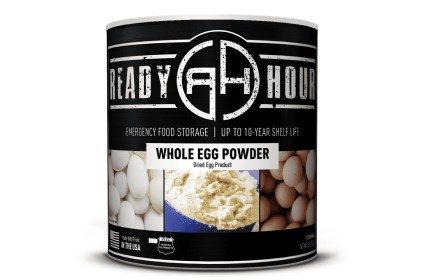
Ready Hour powdered eggs
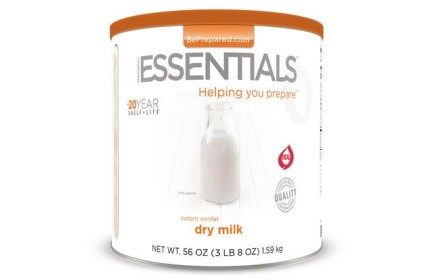
Emergency Essentials powdered milk
Since there’s lot of different options, here’s a list of the top brands that you should shop from:
Be prepared. Don’t be a victim.
Want more great content and giveaways? Sign up for The Prepared’s free newsletter and get the best prepping content straight to your inbox. 1-2 emails a month, 0% spam.
What kinds of food come this way and which ones to avoid
Pretty much anything! You can buy the aforementioned dried milk powder and powdered eggs, but you may be surprised at the variety of foods you can buy this way. Here are some surprising examples:
- Butter
- Green beans
- Ground beef
- Peaches
- Peanut Butter
- Salt
- Sugar
- Tomatoes
The thing about buying these sorts of dehydrated foods is that you pay a premium over what you would in a supermarket. So you want to avoid buying foods this way that store well without much trouble. Some examples:
- Dry beans (lasts for years if properly packaged)
- Honey (lasts forever, crystalized honey can be soaked in warm water)
- White rice (lasts for years if properly packaged)
- Salt (lasts forever with minimal effort)
- Sugar (also lasts forever with minimal effort)
So what makes sense to buy this way? Consider foods that:
- Are otherwise not shelf stable
- Can’t be purchased easily in regular cans
- You and your family regularly eat
Which leads to these good examples:
- Powdered milk
- Powdered eggs (usually not available in supermarkets)
- Powdered butter (butter usually requires refrigeration)
- Cheese (you can buy both powdered cheese and freeze dried shredded cheese)
- Grapes (not typically available wet-canned)
- Broccoli and cauliflower (again, not usually available wet-canned)
- Celery (not sold wet-canned)
- Berries and other fruit (available wet-canned, but packed in sugary syrup)
- Banana chips (usually can’t be canned)
- Tomato powder (canned tomatoes only last about a year due to their high acid content, which eats the can)
- Ground meat
There are other foods that are borderline. For instance, flour can be bought cheaply at the supermarket and packed in mylar bags for a few years, but you may prefer the convenience of storing it in a #10 can.
In our testing, one of the best uses for these ingredients is baking. Many baking staples, such as flour, salt, and oil are shelf stable, but there are other key ingredients that have fairly short lives even in the refrigerator, such as butter, eggs, and milk.
#10 can packaging
Some dried ingredients come in bags, others in buckets, but by far the most common packaging is #10 cans. That’s a “number ten” can, not a 10-pound can. It’s a standardized can size that measures 6 3⁄16-by-7 inches, which holds about 12 3/4 cups. For reference, it’s about the size of a coffee can. Most of the cans in your pantry are probably #300 cans, which are significantly smaller than #10 cans.
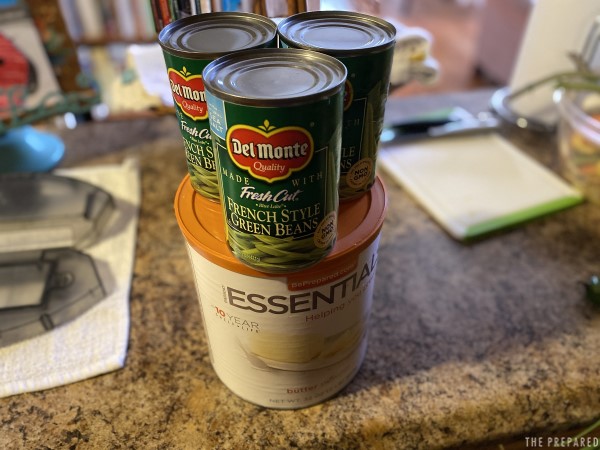
The nice thing about standardized can sizes is that it makes them easier to stack, even if you have ingredients from different vendors. Steel cans are durable, completely block light, and seal out oxygen. Many of these ingredients can last for decades if the can is unopened, and for months after being opened.
Since many of these ingredients last for months after opening, the larger can sizes make sense. Unlike quickly perishable canned vegetables that need to be used as soon as possible after opening, you can pull from a #10 can for a while. While the #10 cans are large, they are actually more space-efficient than the small #300 cans.
#10 cans hold all sorts of different foods. You’ve probably seen them at your super market and definitely if you shop at a warehouse store, since they’re intended for institutional use and large gatherings. But for this review, we’re focusing on dried ingredients with long shelf lives.
How do they make this stuff?
Many foods, like these green beans, are freeze-dried, which is a process that removes all of the moisture from the food while retaining its composition and structure. Coffee and ice cream are other common freeze-dried foods.
The food is placed in a machine that freezes it and then vacuums the air out of the chamber. A small amount of heat is added, and because of the minimal air pressure, the water in the food “sublimates” and is turned directly from ice into water vapor and is removed from the chamber. The resulting freeze-dried foods are much lighter in weight.
Many other foods are simply dried instead of freeze-dried. With foods like banana chips and tomato powder, the produce is sliced and then dried under low heat, and in the case of tomato powder, the dried product is ground into a powder. But some dehydrated foods aren’t that simple.
Powdered milk, butter, and eggs, due to the water content and fat structure are dried out the following ways:
- Powdered milk is put into an evaporator to remove part of its moisture content. Then a separator removes all of the butterfat, the milk is mixed to even the consistency, and then the milk is shot out of a sprayer in a tower. The tiny droplets are air-dried as they fall and become powder.
- Powdered eggs are made in a very similar way to powdered milk: the yellow and whites are shot through a sprayer in a drying tower.
- Butter powder has the water content removed, leaving the fat behind. The butter fat is then processed with milk solids to turn it into a shelf-stable powder, which gives powdered butter a milky taste.
- Margarine powder is basically the same as regular margarine, but there’s extra processing on the milk solids to make it a powder.
True powdered cheese is sprayed like milk. Then there are powdered cheese blends that are largely made of whey powder to reduce costs.
Are dehydrated foods safe?
Generally speaking: yes. As long as you buy your dehydrated foods from reputable suppliers in countries with strong regulations. However, like any processed food, there are some things to be wary of.
The drying process should eliminate most microbes, but not always. In 2016, there was a major recall of foods containing powdered milk that had been contaminated with salmonella. In 2014, 100 tons of powdered eggs were recalled over salmonella concerns. Unfortunately, salmonella contamination is a common occurrence in the United States that’s affected everything from chicken to romaine lettuce, and isn’t limited to powdered foods.
One health concern specific to powdered foods is oxidized cholesterol. Due to the spraying process used to turn foods into powders, the food is exposed to air, which causes oxidation. Oxidized cholesterol has been linked to a number of chronic diseases. Powdered milk isn’t a big risk for oxidized cholesterol because most of the fat is removed, but powdered eggs are a potential risk.
Another concern is that many dehydrated foods are high in sodium content. Since salt is a preservative, many foods with long shelf lives tend to be high in sodium. In a survival situation there may be a lack of available table salt, so food that is high in sodium is not necessarily a bad thing.
Finally, you may wonder if dehydrated foods maintain their nutritional value. Freeze-drying is one of the best ways to preserve food, because it maximizes the retention of nutritional value. However, other drying methods can result in the loss of some vitamins, like A and C.
Shelf life
Unopened, these dried foods can last decades—up to 30 years for freeze-dried foods, 25 years for dehydrated fruits and vegetables, and up to 20 years for powdered milk. However, the flavor of the food may decline over time, while still being edible and nutritious.
The actual shelf life will depend on how you store them. Just as with foods you buy from the supermarket, the enemies of shelf life are heat, light, moisture, pests, and oxygen. A #10 can can protect from all except for the first, so you want to keep your can in a cool place. And while the can will keep water out, you don’t want the can to rust, so you also want a dry place.
Once opened, the shelf life drops dramatically, but is still quite lengthy. Ready Store says once opened, they last 3-12 months, and Emergency Essentials says they last up to a year. Again, the actual shelf life will depend on the five factors listed above. You can throw the opened can in the fridge to make it last longer, or you could even put the food into a mylar bag with an oxygen absorber.
How do I open the cans?
Any regular can opener should do. The #10 cans we tested opened just like a regular-sized can. Don’t forget backups!
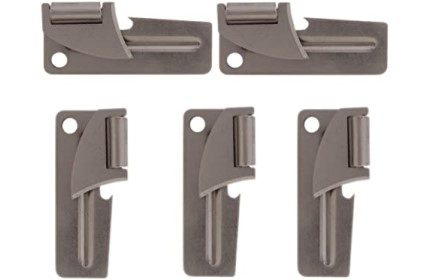
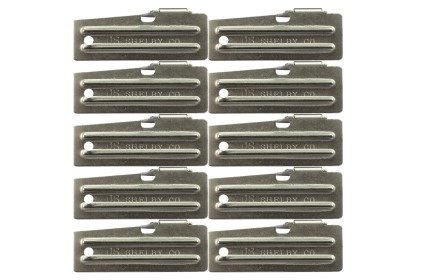
P-51 can opener
Hardcore options cherised by preppers are the P-38 and P-51 can openers made for the US military by the US Shelby Company. The P-51 is a larger can opener better suited for #10 cans. The P-51 is light, simple, and can be found for as cheap as a dollar, so you could buy enough to tape one to each #10 can.
Don’t forget that many multitools, like the Leatherman Wave, feature serviceable can openers, and should be an essential part of your everyday carry.
Preparation tips
All of these ingredients should have instructions and suggestions on the can. But many of them behave differently than their fresh counterparts. Here are some examples:
- Powdered eggs cook much, much faster than fresh eggs.
- You typically want to undercook scrambled eggs a bit, but not so with powdered eggs. If you undercook powdered eggs, they’ll just be mushy and powdery. Cook them thoroughly.
- Don’t try to melt reconstituted powdered butter. It will just burn.
- Freeze-dried fruits and vegetables can be reconstituted, or eaten as is.
Taste tests
From prior tests of other powdered foods like sour cream and eggs, we knew that these products often taste terrible. You might be able to wolf down anything if you’re hungry enough and have enough hot sauce, but we wanted to get a sense of the best-tasting brands so you can stock up with confidence.
We assembled a stockpile of dried ingredients to test. We focused on powdered eggs and powdered butter, since they are both things that are otherwise not shelf stable and they are both sold by the four major brands: Augason Farms, Emergency Essentials, Rainy Day Foods, and Ready Hour.
Here is a complete list of what we tested:
- Augason Farms Dried Whole Egg Powder
- Augason Farms Scrambled Egg Mix
- Augason Farms Butter Powder
- Emergency Essentials Whole Egg Powder
- Emergency Essentials Scrambled Egg Mix
- Emergency Essentials Butter Powder
- Emergency Essentials Instant Nonfat Dry Milk
- Rainy Day Foods Whole Eggs
- Rainy Day Foods Ova Easy Eggs
- Rainy Day Foods Butter Powder
- Ready Hour Whole Egg Powder
- Ready Hour Scrambled Eggs Mix
- Ready Hour Butter Powder
My family tested these in our kitchen, for both smell and taste. All of the egg products were scrambled in a stainless steel skillet with a good amount of vegetable oil. The butter was tasted in both its dry, powdered form and mixed with water to make a reconstituted spread. For the powdered milk, I simply mixed the indicated amount in a large mason jar with a lid.
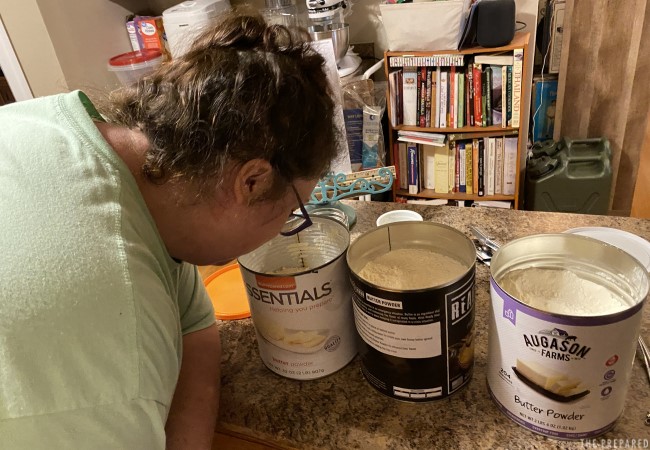
Here were our findings:
- There wasn’t a drastic difference between brands of the same product. Some were better, some worse, but most of them were pretty bad.
- By far the best egg was the Rainy Day Foods Ova Easy Eggs, which are crystalized instead of powdered. Unfortunately, they’re also very expensive — $71.68 for a #10 can, as opposed to $21.69 for a #10 can of whole eggs.
- But the worst powdered eggs were from Rainy Day Foods, so that’s not exactly a bargain.
- All of the “scrambled egg” mixtures were bad: mushy with chemically flavors.
- Powdered butter can make a decent spread, but it’s not quite the same as regular butter.
- The best product out of the lot was the Emergency Essentials powdered milk.
These were our subjective rankings:
- Best Powdered Egg: Rainy Day Ova Crystals (expensive), Ready Hour (best of the powders)
- Best Scrambled Egg: Emergency Essentials
- Best Wet Powdered Butter: Ready Hour
- Best Dry Powdered Butter: Rainy Day
- Worst Powdered Egg: Rainy Day Foods
- Worst Scrambled Egg: Ready Hour, Augason Farms (tie)
- Worst Wet Powdered Butter: Emergency Essentials
- Worst Dry Powdered Butter: Emergency Essentials
Again, there weren’t drastic differences between most of these. Most of the powdered eggs were okay at best and the powdered butters were generally acceptable but a bit milky.
I decided to try using the ingredients in baking to see if they performed better when used in a recipe. I cooked the Martha White Easy Cornbread recipe, except I swapped the milk with Emergency Essentials dry milk (mixed with water) and Ready Hour powdered whole eggs. Everything in the cornbread was shelf stable.
The resulting cornbread was good with no off flavors. It cooked a bit faster than usual: 25 minutes instead of 30.
Next, we made a batch of brownies, following the recipe except swapping in powdered eggs and powdered butter with the specified amounts of water. The resulting brownies tasted good, but were a bit dry, and had a milky taste due to the milk solids in the canned butter. They could probably be improved through the addition of oil or more liquid, but as far as flavor goes, the powdered ingredients are acceptable.
